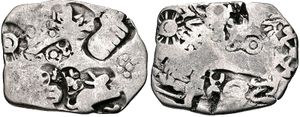أسرة شايشوناگا
Shishunaga Dynasty | |||||||||
|---|---|---|---|---|---|---|---|---|---|
| 413 BCE–345 BCE | |||||||||
![Approximate extent of the Shisshunaga dynasty.[1]](/w/images/thumb/3/31/Magadha_Expansion_%286th-4th_centuries_BCE%29.png/350px-Magadha_Expansion_%286th-4th_centuries_BCE%29.png) Approximate extent of the Shisshunaga dynasty.[1] | |||||||||
| العاصمة | Rajgir (primary) Vaishali (secondary) later Pataliputra | ||||||||
| اللغات المشتركة | Sanskrit Magadhi Prakrit Other Prakrits | ||||||||
| الدين | Hinduism[2] Buddhism Jainism | ||||||||
| الحكومة | Monarchy | ||||||||
| Raja | |||||||||
• 413–395 BCE | Shishunaga | ||||||||
• 395–367 BCE | Kalashoka | ||||||||
• 367–355 BCE | Nandivardhana | ||||||||
• 355–345 BCE | Mahanandin | ||||||||
| التاريخ | |||||||||
• تأسست | 413 BCE | ||||||||
• انحلت | 345 BCE | ||||||||
| |||||||||
The Shishunaga dynasty (IAST: Śaiśunāga, literally "of Shishunaga") was the second ruling dynasty of Magadha, an empire in ancient India. According to the Hindu Puranas, this dynasty was the second ruling dynasty of Magadha, succeeding Nagadashaka of the Haryanka dynasty.
Shishunaga, the founder of the dynasty, was initially an amatya or "minister" of the last Haryanka dynasty ruler Nāgadāsaka and ascended to the throne after a popular rebellion in ح. 413 BCE.[3] The capital of this dynasty initially was Vaishali; but later shifted to Pataliputra, near the present day Patna, during the reign of Kalashoka. According to tradition, Kalashoka was succeeded by his ten sons.[4] This dynasty was succeeded by the Nanda dynasty in ح. 345 BCE.[5]
التأسيس
According to Buddhist tradition, Shishunaga was amatya in Haryanka kingdom, who revolted and became the king.[6]
الحكام
Shishunaga
Shishunaga founded his dynasty in 413 BCE with its capital in Rajgir and later Pataliputra (both in what is now Bihar). Buddhist sources indicate that he had a secondary capital at Vaishali,[6] formerly the capital of Vajji, until it was conquered by Magadha. The Shaishunaga dynasty ruled one of the largest empires in the Indian subcontinent. Shishunaga ended the Pradyota dynasty of Avanti, ending the centuries old rivalry between their kingdoms and annexing Avanti into Magadha.
Kakavarna/Kalashoka
According to the Puranas, Shishunaga was succeeded by his son Kakavarna and according to the Sinhala chronicles by his son Kalashoka.[6] On the basis of the evidence of the Ashokavadana, Hermann Jacobi, Wilhelm Geiger and Ramakrishna Gopal Bhandarkar concluded that both are the same.[بحاجة لمصدر] During Shishunaga's reign, he was the governor of Varanasi. The two most significant events of his reign are the Second Buddhist council at Vaishali in 383 BC and the final transfer of the capital to Pataliputra.[6][7] According to the Harshacharita, he was killed by a dagger thrust into his throat in the vicinity of his capital.[8] According to Buddhist tradition, he had nine or ten sons, who were ousted by Ugrasena Nanda.[9]
الحكام اللاحقون
According to Buddhist tradition,[which?] ten sons of Kalashoka ruled simultaneously. The Mahabodhivamsa states their names as Bhadrasena, Korandavarna, Mangura, Sarvanjaha, Jalika, Ubhaka, Sanjaya, Koravya, Nandivardhana and Panchamaka. Only one of them is mentioned in the Puranic lists, Nandivardhana.[4]
The Puranas list Nandivardhana as the ninth Shaishunaga king and his son Mahanandin as the tenth and the last Shaishunaga king. Mahanandin was killed by Mahapadma, his illegitimate son from a Shudra wife.[10]
الانحدار
According to Puranas, Shaishunagas were followed by the Nanda dynasty, which was founded by Mahanandin's son Mahapadma Nanda.[6]
المراجع
Citations
- ^ Schwartzberg, Joseph E. (1978). A Historical atlas of South Asia. Chicago: University of Chicago Press. p. 145, map XIV.1 (a). ISBN 0226742210.
- ^ Upinder Singh 2016, p. 273.
- ^ Raychaudhuri 1972, pp. 193,201.
- ^ أ ب Raychaudhuri 1972, p. 196.
- ^ Raychaudhuri 1972, p. 201.
- ^ أ ب ت ث ج Upinder Singh 2016, p. 272.
- ^ Raychaudhuri 1972, pp. 195–196.
- ^ Mahajan 2007, p. 251.
- ^ Sastri 1988, p. 14.
- ^ Mookerji 1988, p. 10.
المصادر
- Mookerji, Radha Kumud (1988), Chandragupta Maurya and his times (4th ed.), Motilal Banarsidass, ISBN 978-81-208-0433-3, https://books.google.com/books?id=i-y6ZUheQH8C
- Singh, Upinder (2016), A History of Ancient and Early Medieval India: From the Stone Age to the 12th Century, Pearson PLC, ISBN 978-81-317-1677-9, https://books.google.com/books?id=Pq2iCwAAQBAJ
- Raychaudhuri, H.C. (1972), Political History of Ancient India, Calcutta: University of Calcutta
- Sastri, K. A. Nilakanta, ed. (1988), Age of the Nandas and Mauryas (Second ed.), Delhi: Motilal Banarsidass, ISBN 978-81-208-0465-4, https://books.google.com/books?id=YoAwor58utYC
- Mahajan, V.D. (2007), Ancient India, New Delhi: S. Chand, ISBN 978-81-219-0887-0
| سبقه Haryanka dynasty (Magadha) Pradyota dynasty (Avanti) |
Shaishunaga Dynasty 413–345 BCE |
تبعه Nanda Dynasty |
- Short description is different from Wikidata
- Use dmy dates from December 2015
- Use Indian English from December 2015
- All Wikipedia articles written in Indian English
- Articles with hatnote templates targeting a nonexistent page
- مقالات ذات عبارات بحاجة لمصادر
- All articles with specifically marked weasel-worded phrases
- Articles with specifically marked weasel-worded phrases from January 2016
- Magadha
- History of Bihar
- 5th-century BC establishments in India
- 4th-century BC disestablishments in India
- Kingdoms of Bihar
